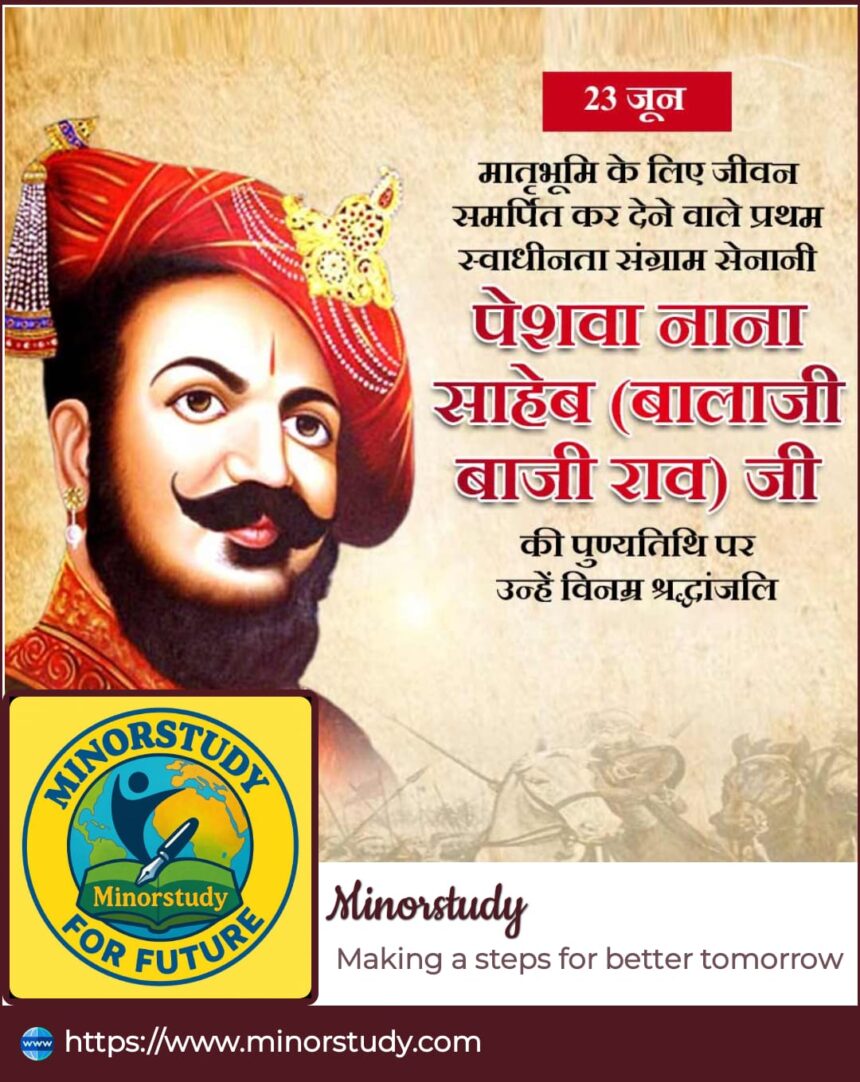🌟 Introduction: Who Was Peshwa Nana Saheb Ji?
Peshwa Nana Saheb, originally named Balaji Baji Rao, was one of the most influential figures in 18th-century Indian politics and governance. As the third Peshwa of the Maratha Empire, he carried forward the strong legacy of his father, Baji Rao I, a military genius whose reign saw the Marathas spread far beyond Maharashtra.
- 🌟 Introduction: Who Was Peshwa Nana Saheb Ji?
- 🕰️ History and Background
- 📜 Key Timeline of Peshwa Nana Saheb Ji’s Life
- 📌 7 Must-Know Facts about Peshwa Nana Saheb
- 🔍 FAQs about Peshwa Nana Saheb
- Q1. Is Peshwa Nana Saheb the same as the 1857 revolutionary?
- Q2. What was Nana Saheb’s biggest achievement?
- Q3. What caused the downfall of his reign?
- Q4. What was his contribution to Pune?
- Q5. Who succeeded him?
- 🎯 Significance in Indian History
- 🙏 Observance and Legacy
- 💬 Wishing & Remembering Nana Saheb Ji Today
- 🧠 Why Peshwa Nana Saheb Still Matters Today
- 📝 Conclusion: A Hero with a Mixed Legacy but an Unforgettable Impact
Balaji Baji Rao Ji, also known respectfully as Peshwa Nana Saheb, held office from 1740 to 1761 and saw both the pinnacle of Maratha power and the devastating fall after the Battle of Panipat. Yet, his contributions in administration, governance, diplomacy, and expansion mark him as a visionary leader in Indian history.
🕰️ History and Background
Full Name: Balaji Baji Rao
Popularly Known As: Peshwa Nana Saheb
Born: December 8, 1720
Father: Baji Rao I
Mother: Kashibai
Appointed as Peshwa: 1740, after the death of his father
Reign: 1740 – 1761
Died: June 23, 1761 (shortly after the Third Battle of Panipat)
Balaji Baji Rao was trained in statecraft and military affairs from a young age. When his father died unexpectedly, the young Balaji was elevated to the role of Peshwa at just 20 years old. He inherited not only the powerful Maratha Empire but also its expanding ambitions and difficult challenges.
📜 Key Timeline of Peshwa Nana Saheb Ji’s Life
| Year | Event |
|---|---|
| 1720 | Born in Saswad, near Pune |
| 1740 | Appointed Peshwa after his father’s death |
| 1741-1751 | Consolidated Maratha power in the Deccan and central India |
| 1752 | Treaty with the Mughal Emperor Ahmad Shah Bahadur |
| 1758 | Maratha forces captured Delhi and Punjab |
| 1761 | Third Battle of Panipat; his son Vishwasrao dies, empire declines |
| 1761 | Dies shortly after the Panipat loss, heartbroken |
📌 7 Must-Know Facts about Peshwa Nana Saheb
Expanded the Maratha Empire: Under his leadership, the Marathas reached as far as Attock in Punjab, a significant military feat.
Excellent Administrator: Known for setting up efficient revenue systems, improving irrigation, and supporting arts and education.
Built the Shaniwar Wada: While his father began the construction, Nana Saheb completed this magnificent fort in Pune.
Strong Diplomacy: Signed treaties with the Mughals, Rajputs, and other regional powers to strengthen the Maratha Confederacy.
Family-Oriented Leader: Extremely close to his son Vishwasrao, whose death at Panipat deeply impacted him.
Established Maratha Supremacy in Delhi: Helped reinstate Mughal emperor Ahmad Shah Bahadur under Maratha protection.
Tragic Ending: The loss at Panipat led to an emotional collapse and eventually his death.
🔍 FAQs about Peshwa Nana Saheb
Q1. Is Peshwa Nana Saheb the same as the 1857 revolutionary?
No. There were two Nana Sahebs:
Balaji Baji Rao (1720–1761): The Peshwa of the Maratha Empire.
Nana Saheb of 1857 (Dhondu Pant): Leader in the First War of Indian Independence.
Q2. What was Nana Saheb’s biggest achievement?
Establishing Maratha influence in North India, particularly Delhi and Punjab, and expanding the empire’s reach.
Q3. What caused the downfall of his reign?
The Third Battle of Panipat (1761), where the Marathas were defeated by Ahmad Shah Abdali, leading to the loss of many prominent generals and his own son.
Q4. What was his contribution to Pune?
He transformed Pune into a major political and cultural center, commissioning public works, temples, and education hubs.
Q5. Who succeeded him?
He was succeeded by his son Madhav Rao I, a brilliant ruler who partially restored the empire’s glory.
🎯 Significance in Indian History
Architect of Maratha Northward Expansion: It was under him that the Maratha power extended beyond Vindhyas into North India.
Consolidator of the Empire: His administration ensured revenue optimization, military strengthening, and judicial reforms.
Bridge between Two Generations: His reign connected the military glory of Baji Rao I and the administrative reforms of Madhav Rao I.
Panipat’s Tragic Hero: Though he wasn’t present on the battlefield, his strategic decisions shaped the outcome, for better or worse.
🙏 Observance and Legacy
While Peshwa Nana Saheb doesn’t have an official remembrance day across India, he is deeply respected in:
Maharashtra, especially Pune and Satara, where his policies are still taught in textbooks.
Historical circles and Maratha heritage scholars, who recognize his vision, sacrifice, and contributions.
Military historians, who regard his expansion as bold and unprecedented.
There are monuments and heritage structures such as Shaniwar Wada and temples built under his patronage, which still stand as silent tributes.
💬 Wishing & Remembering Nana Saheb Ji Today
“May we learn from Peshwa Nana Saheb Ji’s resilience, vision, and commitment to Bharat. His devotion to the Maratha cause and efforts to protect our dharma remain an eternal source of inspiration.”
You can honor his legacy by:
Visiting historic places like Shaniwar Wada.
Reading about Maratha history and understanding its relevance in modern India.
Supporting heritage conservation efforts in Maharashtra and beyond.
🧠 Why Peshwa Nana Saheb Still Matters Today
✅ In Our Lives:
His administrative reforms inspire modern governance and decentralization.
His cultural patronage reflects in Maharashtra’s festivals, music, and literature.
His unity-building approach is crucial in today’s fragmented political climate.
✅ In Society:
Embodies the power of leadership with responsibility.
His downfall also teaches the importance of caution, unity, and military foresight.
A reminder that empires built without robust succession planning and unity can collapse under pressure.
📝 Conclusion: A Hero with a Mixed Legacy but an Unforgettable Impact
Peshwa Nana Saheb Ji, or Balaji Baji Rao, was not just a ruler — he was a visionary, a builder, and a tragic hero. While the battle of Panipat remains a shadow on his achievements, the positive legacy he left behind is far greater.
His life offers lessons in ambition, governance, emotional strength, and even the importance of learning from defeat. For students of history and lovers of Bharat, his story remains eternally relevant.
🔖 Important Points Recap
Born in 1720, succeeded his father Baji Rao I.
Expanded Maratha power significantly.
Known for administrative and cultural development.
Died heartbroken after the tragic Third Battle of Panipat in 1761.
Still remembered for shaping India’s pre-colonial political landscape.








